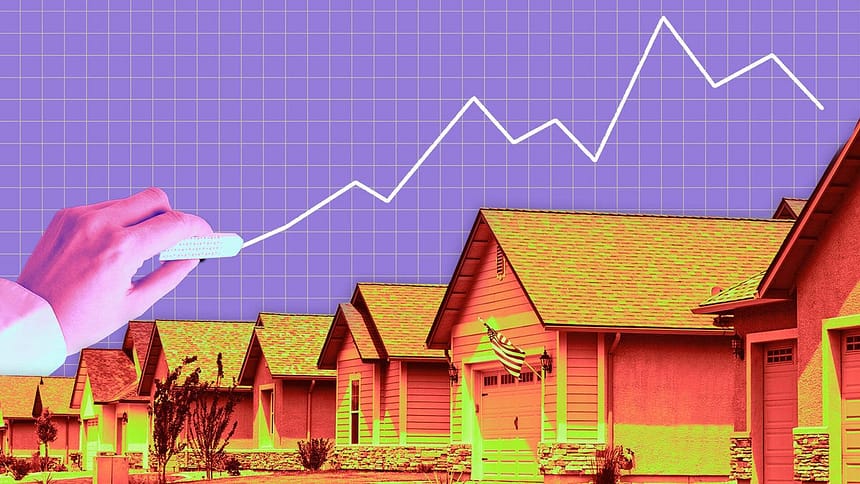
Mortgage rates can change daily and even hourly.
This week, mortgage rates are being influenced by headlines about ongoing trade negotiations and the bond market’s reaction to today’s inflation report.
The April Consumer Price Index report shows price growth at 2.3%, the slowest annual pace in years, and down slightly from the previous month. Though the report was mild, economists don’t expect price growth to continue in this direction. Forecasts show prices will soon accelerate once we see an impact in import taxes.
This comes after the White House announced its 90-day “reset” on steep tariffs with China on Monday, which sparked a surge in stocks and bonds. Mortgage rates, which are pegged to the bond market, specifically the 10-year Treasury yield, saw upward pressure as a result. Between Monday and Tuesday, the average rate for a 30-year fixed rate mortgage jumped from 6.85% to 6.88%, according to Bankrate data.
Following the release of Tuesday’s CPI data, 10-year yields slipped slightly, but not enough to suggest a major drop in mortgage rates is due any time soon.
The temporary reprieve from the steepest levies on China is welcome news for investors, assuaging market fears of deep supply shocks and reducing the recession risk. But economists note that a tariff-induced uptick in prices could still hamper the Federal Reserve’s projected pace of interest rate cuts. Mortgage rates, which are highly sensitive to fiscal policy and economic growth, could increase if inflation stays elevated.
“As the inflation picture becomes clearer later in the year, I think there’s a chance for [rates] to cautiously move lower,” said Keith Gumbinger, vice president at HSH.com.
But absent a recession, which is still a possibility, Gumbinger notes that 30-year fixed mortgage rates aren’t likely to drop below 6.5% in the near term.
How are Trump’s tariffs affecting mortgage rates?
Mortgage rates have faced a bumpy ride this spring due to the Trump administration’s inconsistent trade policies. After Trump announced massive tariffs on April 2, markets slumped and mortgage rates fell before jumping back up one week later following a 90-day pause on some measures.
The recent back and forth in rates mirrors the uncertain impacts of aggressive tariffs on the economy. On one side, tariffs act like a supply shock that makes prices go up, leading to more inflation, said Brett Ryan, senior economist at Deutsche Bank. On the other side, tariffs can slow down the economy and threaten jobs, Ryan said. Recession expectations often bring rates down.
The current trade truce also makes it less likely that the Fed will make any interest rate cuts until late summer at the earliest. Though Tuesday’s inflation reading was better than expected, price growth is still above the Fed’s annual target goal of 2%.
What is the Fed’s next move on interest rate cuts?
Trump’s aggressive tariff agenda has created a dilemma for the Fed.
“Coming into the year, the Fed was prepared to cut rates if the labor market began to weaken, since it seemed like inflation risk had mostly eased,” said Alex Thomas, senior research analyst at John Burns Research and Consulting. “Now, given the potential inflationary impact of wide-reaching tariffs, the Fed will be more hesitant to cut until the labor market weakens significantly.”
The central bank is tasked with maintaining maximum employment and containing inflation via adjustments to its benchmark interest rate. Usually, when prices go up too fast (inflation), the Fed raises interest rates to slow price growth and reduce spending by making borrowing more expensive. Then, when the economy shows signs of weakness and unemployment rises, the Fed tends to lower rates to boost demand and stimulate growth.
Since the Fed can’t address both sides of its dual mandate at once, it will now have to choose between keeping inflation in check and avoiding a severe recession.
After inflation showed ongoing signs of slowing in late 2024, the Fed lowered rates three times but has kept them on pause so far this year, most recently during its May 7 meeting.
Experts say it’s increasingly likely that borrowing rates will stay high throughout the first half of 2025.
Should you wait for rates to fall before buying a home?
In today’s housing market, prospective buyers have multiple reasons to postpone plans of homeownership. Elevated mortgage rates, steep home prices and limited inventory have created a cost-prohibitive barrier and kept overall housing activity low.
Still, homeownership offers the promise of long-term financial stability and generational wealth-building through equity. If you’re waiting for mortgage rates to come down before buying, keep in mind that the large-scale economic issues affecting the housing market are beyond your control.
“Trying to time everything perfectly is a losing proposition. Rates could go up or they could go down,” said Gregory Heym, chief economist at Brown Harris Stevens. “The question is: Do you want a home?”
When weighing the pros and cons of homeownership, experts recommend focusing on two key fundamentals:
Make a homebuying budget and stick to it: Creating a realistic homebuying budget can help you decide if you can handle the costs of homeownership, and provide you with some figures for how large your mortgage should be.
Shop around for mortgage rates: Each home loan lender offers different mortgage rates and terms. Comparing offers from multiple lenders can help you negotiate a better rate. If you can’t snag a low rate but are ready to buy, you can always refinance down the road.
Watch this: 6 Ways to Reduce Your Mortgage Interest Rate by 1% or More





